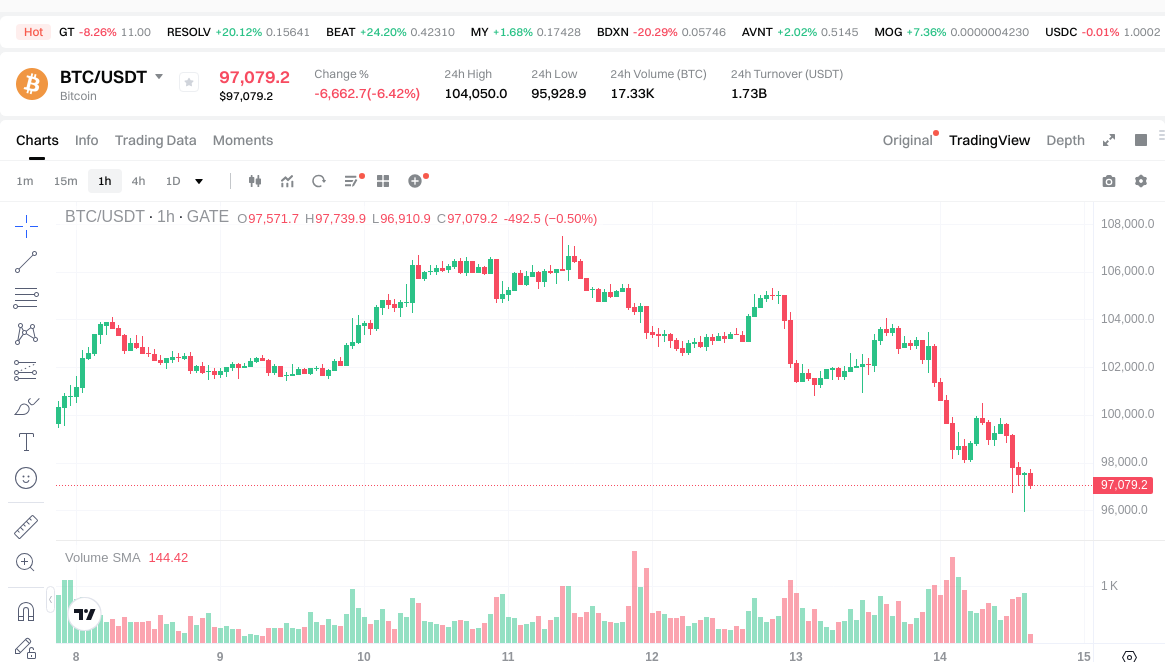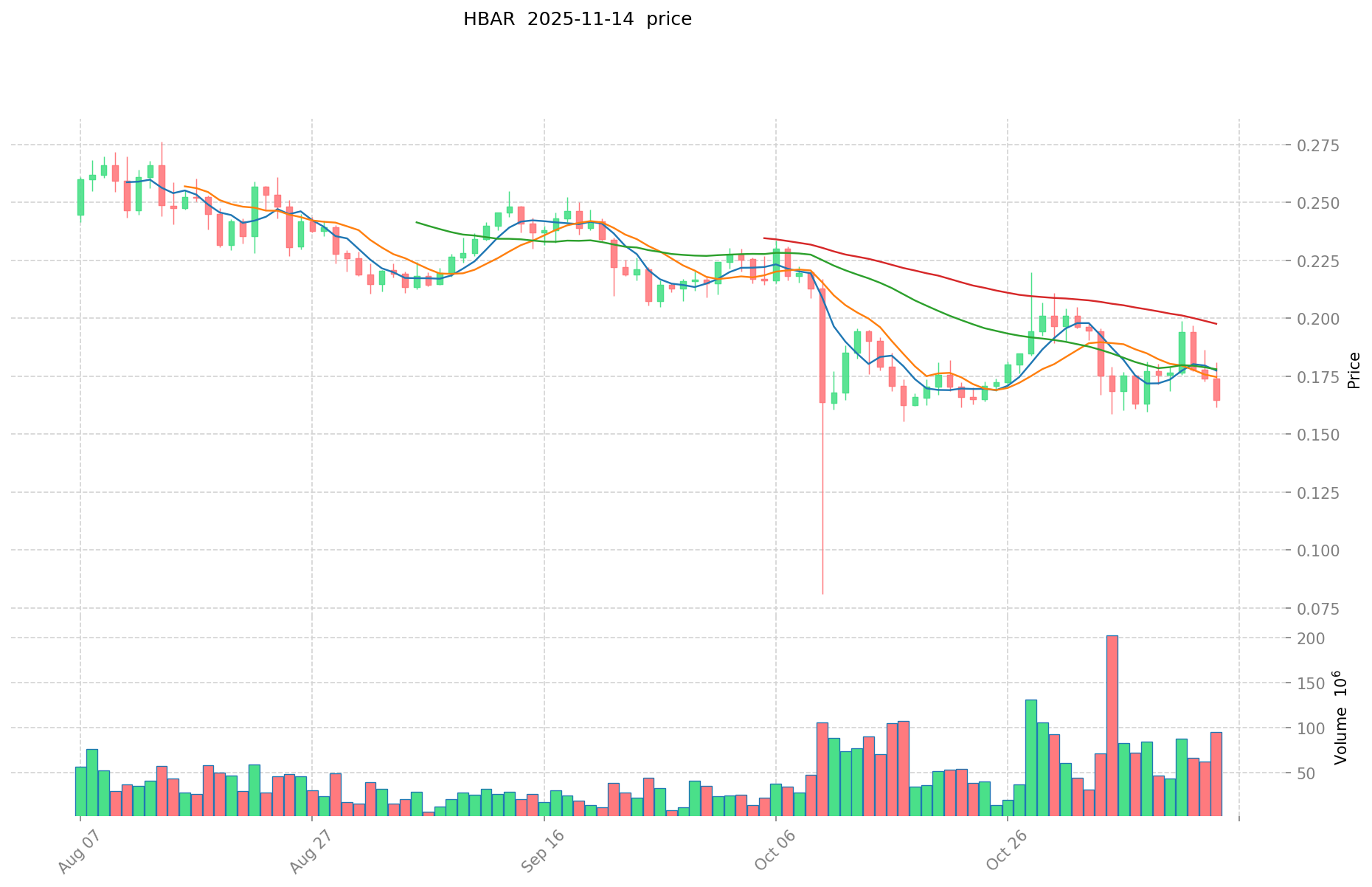BTC vs HBAR: A Clash of Titans in the Cryptocurrency Arena
Introduction: BTC vs HBAR Investment Comparison
In the cryptocurrency market, Bitcoin vs Hedera has always been a topic that investors can't ignore. The two not only have significant differences in market cap ranking, application scenarios, and price performance, but also represent different positioning in crypto assets.
Hedera (HBAR): Since its launch in 2019, it has gained market recognition for its fast, secure, and fair public ledger network using hashgraph consensus.
Bitcoin (BTC): Since its inception in 2008, it has been hailed as "digital gold" and is one of the cryptocurrencies with the highest global trading volume and market capitalization.
This article will comprehensively analyze the investment value comparison between Hedera and Bitcoin, focusing on historical price trends, supply mechanisms, institutional adoption, technological ecosystems, and future predictions, and attempt to answer the question that investors are most concerned about:
"Which is the better buy right now?"
I. Price History Comparison and Current Market Status
Bitcoin (BTC) and Hedera (HBAR) Historical Price Trends
- 2021: HBAR reached its all-time high of $0.569229 on September 15, 2021.
- 2020: HBAR hit its all-time low of $0.00986111 on January 3, 2020.
- Comparative analysis: BTC has seen a significant price increase over the years, with its all-time high of $126,080 recorded on October 7, 2025, while its all-time low was $67.81 on July 6, 2013.
Current Market Situation (2025-11-14)
- BTC current price: $97,141
- HBAR current price: $0.16241
- 24-hour trading volume: BTC $1,734,581,097.77 vs HBAR $17,142,356.53
- Market Sentiment Index (Fear & Greed Index): 16 (Extreme Fear)
Click to view real-time prices:
- Check BTC current price Market Price
- Check HBAR current price Market Price


II. Core Factors Affecting BTC vs HBAR Investment Value
Supply Mechanism Comparison (Tokenomics)
- BTC: Fixed supply of 21 million coins with halving mechanism every four years, creating scarcity and deflationary pressure
- HBAR: Allocated supply of 50 billion tokens with controlled distribution and release schedule
- 📌 Historical Pattern: BTC's halving events historically precede bull markets, while HBAR's controlled release aims to minimize volatility but lacks BTC's proven scarcity-driven price appreciation cycles.
Institutional Adoption and Market Applications
- Institutional Holdings: BTC enjoys significantly broader institutional adoption with major players like MicroStrategy, Tesla, and various ETFs holding billions in BTC, while HBAR has strategic partnerships but less significant institutional capital allocation
- Enterprise Adoption: HBAR leads in enterprise use cases through the Hedera Governing Council (Boeing, Google, IBM), focusing on practical applications like tokenization and settlement, while BTC serves primarily as a store of value and investment vehicle
- National Policies: BTC faces mixed regulatory approaches globally with some countries accepting it as legal tender (El Salvador) while others impose restrictions; HBAR generally faces less regulatory scrutiny due to its enterprise-focused, compliance-oriented approach
Technical Development and Ecosystem Building
- BTC Technical Upgrades: Lightning Network expansion improving scalability and transaction speeds, with continued focus on security and decentralization rather than feature expansion
- HBAR Technical Development: Advancing smart contract functionality, tokenization capabilities, and sustainable consensus mechanism, with higher transaction throughput
- Ecosystem Comparison: BTC ecosystem focuses on financial applications and store of value with growing Lightning Network adoption; HBAR emphasizes enterprise solutions, supply chain, tokenization services, and carbon-negative operations
Macroeconomic Factors and Market Cycles
- Performance in Inflationary Environments: BTC has demonstrated stronger anti-inflationary characteristics, increasingly viewed as "digital gold" during periods of currency devaluation
- Macroeconomic Monetary Policy: Both assets show sensitivity to Federal Reserve policies and interest rates, with BTC historically more correlated to broader market risk sentiment
- Geopolitical Factors: BTC benefits from increased cross-border transaction demand during political instability, while HBAR's enterprise focus may provide more stability during market volatility
III. 2025-2030 Price Prediction: BTC vs HBAR
Short-term Prediction (2025)
- BTC: Conservative $50,480 - $97,077 | Optimistic $97,077 - $119,405
- HBAR: Conservative $0.112 - $0.162 | Optimistic $0.162 - $0.185
Mid-term Prediction (2027)
- BTC may enter a bull market, with prices expected in the range of $111,851 - $153,626
- HBAR may enter a growth phase, with prices expected in the range of $0.174 - $0.254
- Key drivers: Institutional capital inflow, ETF, ecosystem development
Long-term Prediction (2030)
- BTC: Base scenario $166,932 - $196,391 | Optimistic scenario $196,391 - $272,984
- HBAR: Base scenario $0.265 - $0.276 | Optimistic scenario $0.276 - $0.381
Disclaimer: This analysis is based on historical data and projections. Cryptocurrency markets are highly volatile and unpredictable. This information should not be considered as financial advice. Always conduct your own research before making investment decisions.
BTC:
| 年份 | 预测最高价 | 预测平均价格 | 预测最低价 | 涨跌幅 |
|---|---|---|---|---|
| 2025 | 119405.079 | 97077.3 | 50480.196 | 0 |
| 2026 | 161279.372355 | 108241.1895 | 84428.12781 | 11 |
| 2027 | 153626.72025735 | 134760.2809275 | 111851.033169825 | 38 |
| 2028 | 201870.900829395 | 144193.500592425 | 139867.69557465225 | 48 |
| 2029 | 219750.8949028557 | 173032.20071091 | 115931.5744763097 | 78 |
| 2030 | 272984.2514515671615 | 196391.54780688285 | 166932.8156358504225 | 102 |
HBAR:
| 年份 | 预测最高价 | 预测平均价格 | 预测最低价 | 涨跌幅 |
|---|---|---|---|---|
| 2025 | 0.18525 | 0.1625 | 0.112125 | 1 |
| 2026 | 0.2260375 | 0.173875 | 0.1564875 | 8 |
| 2027 | 0.2539444375 | 0.19995625 | 0.1739619375 | 24 |
| 2028 | 0.2473758746875 | 0.22695034375 | 0.17248226125 | 41 |
| 2029 | 0.315426935260937 | 0.23716310921875 | 0.220561691573437 | 47 |
| 2030 | 0.381287130690984 | 0.276295022239843 | 0.26524322135025 | 72 |
IV. Investment Strategy Comparison: BTC vs HBAR
Long-term vs Short-term Investment Strategies
- BTC: Suitable for investors seeking store of value, inflation hedge, and long-term growth potential
- HBAR: Suitable for investors interested in enterprise blockchain solutions and ecosystem development
Risk Management and Asset Allocation
- Conservative investors: BTC 70% vs HBAR 30%
- Aggressive investors: BTC 60% vs HBAR 40%
- Hedging tools: Stablecoin allocation, options, cross-currency portfolios
V. Potential Risks Comparison
Market Risks
- BTC: High volatility, susceptibility to market sentiment and macroeconomic factors
- HBAR: Lower liquidity, potential for price manipulation in smaller markets
Technical Risks
- BTC: Scalability issues, network congestion during peak times
- HBAR: Centralization concerns, potential vulnerabilities in hashgraph consensus
Regulatory Risks
- Global regulatory policies may impact both differently, with BTC facing more scrutiny as a potential threat to traditional financial systems
VI. Conclusion: Which Is the Better Buy?
📌 Investment Value Summary:
- BTC advantages: Established market leader, strong network effect, proven store of value
- HBAR advantages: Enterprise adoption, scalability, energy-efficient consensus mechanism
✅ Investment Advice:
- New investors: Consider a higher allocation to BTC for exposure to the broader crypto market
- Experienced investors: Balanced portfolio with both BTC and HBAR, adjusting based on risk tolerance
- Institutional investors: Explore BTC for treasury reserves and HBAR for potential enterprise blockchain applications
⚠️ Risk Warning: Cryptocurrency markets are highly volatile. This article does not constitute investment advice. None
VII. FAQ
Q1: What are the main differences between Bitcoin (BTC) and Hedera (HBAR)? A: Bitcoin is a decentralized cryptocurrency focused on being a store of value and digital gold, while Hedera is a public distributed ledger platform designed for enterprise applications. BTC has a fixed supply of 21 million coins, while HBAR has an allocated supply of 50 billion tokens. Bitcoin uses proof-of-work consensus, while Hedera uses a more energy-efficient hashgraph consensus mechanism.
Q2: Which has shown better price performance historically, BTC or HBAR? A: Bitcoin has shown significantly better price performance historically. BTC reached an all-time high of $126,080 in October 2025, while HBAR's all-time high was $0.569229 in September 2021. BTC has also demonstrated a longer track record of price appreciation and market cycles.
Q3: How do institutional adoption and market applications differ between BTC and HBAR? A: Bitcoin has broader institutional adoption, with major companies and investment funds holding significant amounts of BTC. HBAR, while having strategic partnerships through its Governing Council (including Boeing, Google, and IBM), focuses more on enterprise use cases and practical applications like tokenization and settlement.
Q4: What are the key factors affecting the future price predictions for BTC and HBAR? A: Key factors include institutional capital inflow, regulatory developments, technological advancements, macroeconomic conditions, and ecosystem growth. For BTC, halving events and its role as a store of value are particularly important. For HBAR, enterprise adoption and the expansion of its use cases in various industries are crucial.
Q5: How do the investment strategies differ for BTC and HBAR? A: BTC is generally seen as more suitable for long-term investment strategies, serving as a store of value and inflation hedge. HBAR is often considered for investors interested in enterprise blockchain solutions and ecosystem development. A balanced portfolio might include both, with allocations adjusted based on risk tolerance and investment goals.
Q6: What are the main risks associated with investing in BTC and HBAR? A: Both face market risks such as price volatility and regulatory uncertainty. BTC-specific risks include scalability issues and network congestion. HBAR-specific risks include lower liquidity and potential centralization concerns. Both are subject to technical risks and the overall volatility of the cryptocurrency market.
Q7: Which is considered the better buy for different types of investors? A: For new investors, BTC might be considered a better buy due to its established market position and broader adoption. Experienced investors might consider a balanced portfolio including both BTC and HBAR. Institutional investors might explore BTC for treasury reserves and HBAR for potential enterprise blockchain applications. The choice ultimately depends on individual investment goals, risk tolerance, and market outlook.
Share
Content